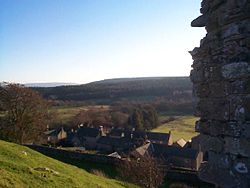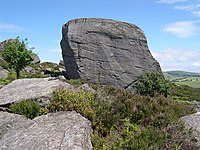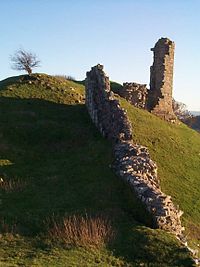Harbottle
| Harbottle | |
| Northumberland | |
|---|---|
 The village from Harbottle Castle | |
| Location | |
| Grid reference: | NT934046 |
| Location: | 55°20’10"N, 2°6’22"W |
| Data | |
| Population: | 256 (2011) |
| Post town: | Morpeth |
| Postcode: | NE65 |
| Dialling code: | 01669 |
| Local Government | |
| Council: | Northumberland |
| Parliamentary constituency: |
Berwick-upon-Tweed |
Harbottle is a village in northern Northumberland, in Upper Coquetdale, nestled among the Cheviot Hills. The village is within the Northumberland National Park, and about 10 miles from the edge of Roxburghshire, which is reached up the long course of the river.
The River Coquet flows by the village. Here too stand the ruins of Harbottle Castle, built by order of King Henry II. Now in ruins, the castle was constructed by the Umfraville family to protect against invaders from Scotland.
The name 'Harbottle' is an early Anglo-Saxon name containing the typically Anglian element botl, meaning "settlement".
Contents
History
The National Gazetteer (1868)[1] comments as follows:
HARBOTTLE, a township in the parish of Alwinton, W. division of Coquetdale ward, county Northumberland, 8 miles W. of Rothbury, and 24 W. of Morpeth, situated on the river Coquet. Here was anciently a strong castle, the seat of the lords of the marshes. It was built anterior to 1075, and was twice taken by the Scots, in 1173 and 1314, after the battle of Bannockburn. Queen Margaret retired here in 1518, on her marriage with Lennox. The English Presbyterian church is a stone structure, and was rebuilt in 1854. There are parochial and Sunday schools. The former has an endowment of £16 per annum, for the education of 12 children. At the E. end of the village on the banks of the river Coquet, is Harbottle Castle, the seat of Percival Fenwick Clennell, Esq. A cattle fair is held on the 19th September.
Sights about the village
The Drake Stone punctuates the hills surrounding Harbottle. The massive erratic sandstone boulder, believed in times past to be endowed with supernatural powers, was deposited by a glacier during the Ice Age. Harbottle Lake is situated just behind it.
The Harbottle Show is a country show held annually in a field immediately adjacent to the village. It is fairly successful but its popularity is dwarfed by that of the Alwinton show that is held in the nearby Alwinton, just up the dale, later in the year.
Harbottle has a single small public house: The Star Inn.
The castle
Harbottle Castle is a ruinous mediæval castle situated at the west end of the village overlooking the River Coquet. It is a Scheduled Ancient Monument and a Grade I listed building.
It is thought that the mound on which the keep stands was a site used by the ancient Britons and that in Anglo-Saxon times there was a stronghold on the site held by Mildred, son of Ackman. The present castle was built about 1160 by the Umfraville family at the request of King Henry II on land awarded to them following the Norman Conquest. Not long after its erection, in 1174, the castle was taken by the Scots and was then rebuilt more strongly. In 1296 it was besieged by Robert de Ros and some 40,000 men, but the siege was withheld. In the 1310s Robert the Bruce captured the castle. It was restored in 1336, but in ruins again by 1351. It was repaired at the end of the 14th century and in about 1436 the castle passed into the hands of the Tailleboys following the death of Robert de Umfraville, the last of his line. It was for a long time the residence of the Warden of the Middle Marches and used as a prison.
In 1515 Margaret Tudor, the widowed queen of James IV of Scotland and sister of Henry VIII, was banished by the regent, the John Stewart, Duke of Albany, and came to Harbottle Castle with her second husband, the Archibald Douglas, 6th Earl of Angus. While there, a daughter was born, who was also called Margaret. Margaret was to become the mother of Lord Darnley, the second husband of Mary, Queen of Scots, and grandmother of James VI and I.
Further building work took place between 1541 and 1551 and more repairs were made in 1563.
In 1605 King James I granted the castle and manor to George Home, Lord Treasurer of Scotland, but thereafter the castle fell into decay and much of its masonry was used in other buildings. A survey of 1715 reported the castle to be ruinous once more. Today only earthworks and some standing masonry remains.
Following the abandonment of the castle as a residence the name was reused: the Harbottle Castle of today is a 19th-century mansion house situated at the east end of the village, and stone from the derelict mediæval castle was used in the building of a 17th-century manor house. The manor was acquired by Percival Clennell in 1796 and in 1829 the house was replaced on the site with a two storied five bayed mansion designed by architect John Dobson. The house is protected with Grade II listed building status.
Gallows
A 19th-century document authored by the Society of Antiquaries of Newcastle upon Tyne describes the location and history of gallows near Harbottle:
The Harbottle gallows occupied an elevated site on a high ridge of moorland stretching between the villages of Harbottle and Holystone, about 800 feet above the sea-level, one mile south of Harbottle castle, the border stronghold of the potent Umfravilles. This hill is yet known as 'Gallow Edge.' How Gilbert de Umfraville, lord of Redesdale and Harbottle (circa 1300), exercised his almost regal powers within his franchise there, we gather from the charges brought against him in the Hundred Rolls. One of those charges shows the swift and savage manner in which capital punishment was inflicted by that cruel and unscrupulous baron. Thomas de Holm was taken within the franchise, but he escaped from the dungeon of Harbottle castle, and fled for refuge to the altar in Alwinton church, where, before the coroner, he forswore his country; but Simon Smart and Benedict Grey, porter of Harbottle, beheaded him at 'Simonseth' (Simonside near Rothbury, beyond his franchise) in the body of the county, and took his head thence, and hung it on the gallows at Harbottle.[2]
See also
Outside links
| ("Wikimedia Commons" has material about Harbottle) |
References
Fry, Plantagenet Somerset, The David & Charles Book of Castles, David & Charles, 1980. ISBN 0-7153-7976-3

